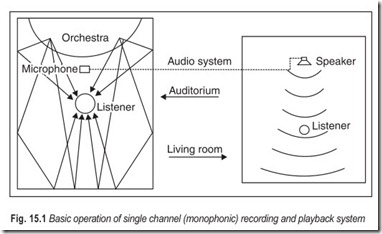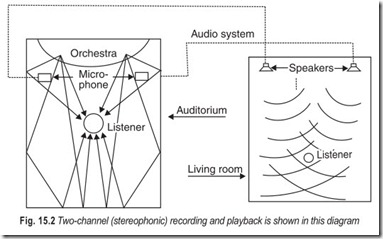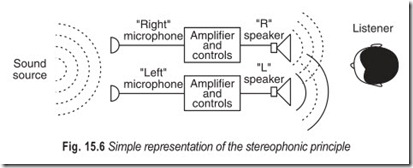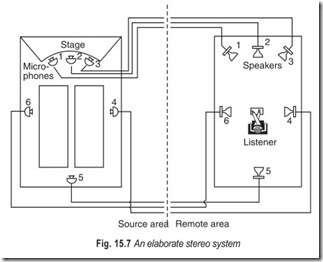MONO, STEREO AND QUAD
High fidelity means the reproduction of sound with a high degree of faithfulness to the original. The whole chain of hardware – from the microphones which recorded the sound to the loudspeakers that reproduced the sound in your living room—has been improved to the point where there is practically no difference in the live and recorded sound. The audio industry had actually arrived at this point, using a single channel of sound (monophone) back in the late 1950s.
MONOPHONY
The word monophony is derived from two Greek roots: mono meaning one and phone meaning sound. Thus the combined roots mean one sound or, as we use it in hi-fi parlance, one-source sound. To be more specific, monophony (mono) signifies, one-source sound, one-amplifier channel, one-speaker system.
Yet another term used in describing monophonic sound is monaural. Since mono means one and auris means, ear, the root of monaural is one-ear. However, due to limited scope of the word monaural the word monophonic, meaning one channel from start to finish, has superseded it.
Figure 15.1 is a simplified illustration of how an orchestra was recorded, back in the late 1950’s. Sometimes multiple microphones were used in a session, but they were mixed down to a single signal which eventually made its way to the listening room environment of your home. But there was still something missing from the concert-hall environment.
STEREOPHONY
The word stereophony is also derived from two Greek roots, stereo meaning solid and phone meaning sound. Thus stereophony denotes solid or three dimensional sound sound coming from different sources, at different locations, with different volume levels (two or more separate channels and speaker systems).
The other term often associated with hi-fi systems is binaural. This word is derived from two roots: bi meaning two and auris meaning ear. Thus binaural may be literally translated as two ear sound.
In a monophonic sound system, the sound usually emanates from only one location when being reproduced. Dual speakers, large horns, and location of the speaker in a corner of the room can be used to spread the sound so that it is difficult to place the sound source at one point. However, there is no stereo effect until two separate channels utilising several microphones, amplifiers and speaker systems are used. While monophonic sound may be very pleasing to listen to, stereophonic sound has advantages for the music lover that cannot be equalled by monophonic systems.
The association of binaural sound with stereo—sound arises from the fact that the binaural system was an early method of obtaining stereo effect. The basic idea behind binaural techniques is the fact that we, as human beings, have a sensation of direction in the sound we hear, because our two ears work separately. The sound sensation to the brain from one ear is kept separate from the sound sensation from the other ear, and both are transmitted to the brain through separate auditory nerves. The brain compares the two auditory signals received by the ears and, from the differences between them, determines the direction from which the sound came.
The theory behind stereophonic systems (binaural systems) is that if the two sound signals, which would be heard by a pair of human ears at the source, are transmitted, reproduced in the same relationship, and applied to the corresponding ears at a remote location, all the directional effects of direct line listening will be preserved.
Stereo was developed in the late 1950’s and increased the concert-hall feeling considerably. As Fig.15.2 shows, an orchestra was no longer beamed to the listener from a single point but was dispersed across a line stretching between two speakers in a virtual curtain of sound. The recorded orchestra was now beginning to sound like its live counterpart.
Modern stereophonic sound, with its directivity and depth properties, adds the third dimension to the sound. It makes clear distinction between foreground, middle and background, as well as between right, middle and left sound sources. Stereo has therefore been able to produce a greater amount of clarity and instrumental sound colour than monophonic sound. The reception of complex sound sources is also made possible. The directional effects and small time delays from echoing and reverberation of the elemental sounds of music are separately channeled from source to ear, thus providing high-quality simulation of live music.
However, one still did not have the illusion of being there. The problem pertains to how our ears and brain interpret sound – psycho-acoustics. In a concert hall, we are immersed in the sound coming from all directions: the direct sound from the orchestra on stage, the reflected sound bouncing off the side walls, the ceiling, and the rear wall; and the sounds of audience clapping, talking, coughing, or moving in their seats. All of these sounds are present in the hall during a live concert.
Acoustic engineers have always been concerned with the liveness or ambience of a particular hall. Four-channel sound was conceived as a means of fooling your brain into thinking you are at a live performance. It is an illusion of being there.
The entire electronics industry is a dynamic one because of change; and each change has improved the overall enjoyment of the consumer. From radio to television, from black and white TV to colour TV, from tubes to transistors, from transistors to integrated circuits, from wire to magnetic tape each step has caused some problems, but they were easily overcome. The advent of four-channel does not mean that two-channel sound is obsolete any more than colour television killed black and white television.
QUADRAPHONY
The word quadraphonic is derived from two roots, quad meaning four and phone meaning sound. Thus quadraphony denotes four-channel sound; see Fig. 15.3.
Let us now look at the various ways of achieving four-channel sound. The most straight forward method is called discrete. This is a copy of the master tape which consists of the two tracks of music that was fed to the microphones near the orchestra and two tracks picked up by microphones placed out in the hall itself- generally toward the rear. These four channels of music are recorded onto a tape and reproduced by means of a tape player that is equipped to pick up the four channels of music and send them through four amplifiers to four speakers, as shown in Fig. 15.4.
In this way, the orchestra comes to you from the front speakers, while the rear speakers re-create the ambience of the hall. You are literally there, immersed in the hall and depending upon your seating preference, you can adjust the front and rear balance, and put yourself in the front row, middle row or away in the back.
An interesting by product of four-channel sound is in the field of pop music which was never performed in a concert hall. The four channels can be used to surround the listener with singers or instrumentalists in the group.
At times, four-channel sound with the rear channels containing the ambience material is pleasing, while at other times the surround-sound effect of being immersed in the music is preferable. Musical enjoyment like art, is a very personal thing.
The matrix method of achieving four-channel sound consists of encoding four channels of information into two channels by mixing them together in a complex phase and amplitude relationship; see Fig. 15.5.
These two channels of information can then be pressed into a normal stereo record, broadcast over an FM-stereo station, or recorded onto a two-channel stereo tape. When you play these two channels of music through the proper equipment, including a matrix decoder, the two channels will be restored somewhat to the original four channels.
Various companies have introduced matrix decoders. There are two main factors to be considered—one is the coefficients and the other is phasing. The coefficients are the terms in formulas that specify how much of each channel is mixed or separated from another. The phasing is an attempt to gain more distinctness between the channels. A commonly used phase shift is 180 degrees. The more complicated matrix circuits use 90 degree phase shifts.
The degree of separation between channels from a matrix system is much less than with a discrete system. There is more blending of the channels in matrixing. The matrix system can be used for two-channel records, tape and FM stereo. The matrix decoder can sometimes be used to enhance normal two-channel stereo music.
STEREO PRACTICE
The basic components of a monophonic system can be adapted to two-channel stereo by adding yet another channel of amplification and an additional speaker system as shown in Fig. 15.6. The sytem is designed to have each speaker reproduce the sound which is present at its corresponding position at the source.
In stereo practice, proper positioning of the equipment and audience is an important consideration. Another important consideration is speaker and microphone placement—how far apart the microphones should be from each other when recording and how far the speakers should be from each other when reproducing the recording.
If the microphones and speakers are too close to each other, they will appear as one, and we will then have a monophonic system. If the listener stands at a considerable distance, they would still effectively appear as one source. If the listener moves closer, until his distance from speakers is comparable with the distance between them, the stereophonic effect is re-estabilshed.
If, on the other hand, we spread the microphones and the speakers very far apart, they would be so distant that they would hardly pick-up any sound and reproduce it so it could be heard. Slightly closer together, but still widely spaced, the reproduced sound would be heard from two separate and distinct sources. This effect is known as hole-in-the middle, because nothing seems to be coming from the area between the two speakers, wheras the centre of the orchestra would be at this point at the source.
To overcome the hole-in-the-middle effect, stereo may employ any number of channels, Fig. 15.7. An elaborate arrangementmay provide for pick-up of an orchestra with six to twelve microphones proportionately spaced around the orchestra, with a corresponding number of amplifiers to reproduce the program. The amplifiers feed the speakers which are placed at the points where microphones were located in the original recording.
To provide signals for the third speaker, three microphones, properly spaced from left to right, may be employed at the sound source. The signal from the middle microphone is mixed with the signals from the left and right microphones and the resultant signals are fed to the left and right channels respectively. Thus the left and right channels contain a certain proportion of the effects of the centre microphone output.
The signal at the output of the preamplifiers may be divided so that the majority of the output from either channel is fed to its respective left or right speaker, but less than one-third of the output of each channel is fed to the centre speaker, which operates at a lower input level than the other two.
The stereo effect is produced over a greater area by the third speaker. The listener can move towards or away from the left or right speakers without losing the stereo effect. The illusion of a curtain of sound spreading across the three speakers is developed.
EXERCISES
Descriptive Questions
1. Explain the difference between a mono and a stereo system.
2. How four-channel sound has evolved?
3. What are the different methods of achieving four-channel sound?
4. What are the factors to be considered in matrix decoders?
5. Discuss the significance of third speaker in eliminating hole-in-the-middle.
6. With the help of a simplified diagram, explain the working of an elaborate stereo system.
Multiple Choice Questions
1. Mono signifies
(a) two sound sources, two channels, and two speaker systems
(b) one sound source, one channel, and one speaker system
(c) either (a) or (b)
(d) neither (a) nor (b)
2. Stereo
(a) increases the concert hall feeling considerably
(b) decreases the concert hall feeling consideably
(c) enhances the concert hall feeling
(d) none of the above
3. Important considerations in stereo practice are
(a) proper positioning of the equipment and audience
(b) proper placement of speakers and microphones
(c) both (a) and (b)
(d) neither (a) nor (b)
4. The stereo effect is
(a) produced over a lesser area by the third speaker
(b) not produced by the third speaker
(c) produced over a greater area by the third speaker
(d) enhanced by the third speaker
Fill in the Blanks
1. Mono means …………………………………….. from start to finish .
2. There is no stereo effect until…………………………………….. utilising several microphones, amplifiers and speaker systems are used.
3. Quadraphony is an extension of …………………………………….. .
4. The most straight forward method in quad is called …………………………………….. .
5. An interesting by product of four-channel sound is in the field of …………………………………….. .
6. The degree of separation between the channels from a matrix system is …………………………………….. than that with a discrete system.
ANSWERS
Multiple Choice Questions
1. (b) 2. (c) 3. (b) 4. (c)
Fill in the Blanks |
||
|
1. one channel 4. discrete |
2. two separate channels 5. pop music |
3. two channel sound 6. much less |






